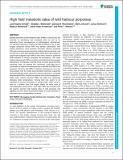High field metabolic rates of wild harbour porpoises
Abstract
Reliable estimates of field metabolic rates (FMRs) in wild animals are essential for quantifying their ecological roles, as well as for evaluating fitness consequences of anthropogenic disturbances. Yet, standard methods for measuring FMR are difficult to use on free-ranging cetaceans whose FMR may deviate substantially from scaling predictions using terrestrial mammals. Harbour porpoises (Phocoena phocoena) are among the smallest marine mammals, and yet they live in cold, high-latitude waters where their high surface-to-volume ratio suggests high FMRs to stay warm. However, published FMR estimates of harbour porpoises are contradictory, with some studies claiming high FMRs and others concluding that the energetic requirements of porpoises resemble those of similar-sized terrestrial mammals. Here, we address this controversy using data from a combination of captive and wild porpoises to estimate the FMR of wild porpoises. We show that FMRs of harbour porpoises are up to two times greater than for similar-sized terrestrial mammals, supporting the hypothesis that small, carnivorous marine mammals in cold water have elevated FMRs. Despite the potential cost of thermoregulation in colder water, harbour porpoise FMRs are stable over seasonally changing water temperatures. Varying heat loss seems to be managed via cyclical fluctuations in energy intake, which serve to build up a blubber layer that largely offsets the extra costs of thermoregulation during winter. Such high FMRs are consistent with the recently reported high feeding rates of wild porpoises and highlight concerns about the potential impact of human activities on individual fitness and population dynamics.
Citation
Rojano-Doñate , L , McDonald , B I , Wisniewska , D M , Johnson , M , Teilmann , J , Wahlberg , M , Højer-Kristensen , J & Madsen , P T 2018 , ' High field metabolic rates of wild harbour porpoises ' , Journal of Experimental Biology , vol. 221 , no. 23 , jeb185827 . https://doi.org/10.1242/jeb.185827
Publication
Journal of Experimental Biology
Status
Peer reviewed
ISSN
0022-0949Type
Journal article
Description
This study was partly funded by the German Federal Agency for Nature Conservation (BfN) under the project ‘Under Water Experiments’ (project number FKZ 3515822000) and the BfN Cluster 7 ‘Effects of underwater noise on marine vertebrates’ (Z1.2-53302/2010/14) with additional support to P.T.M. and L.R.-D. from the Danish National Research Foundation (FNU) and the Carlsberg Foundation. B.I.M. was supported by a National Science Foundation International Research Postdoctoral Fellowship (OISE – 1150123). M.J. was supported by the Marine Alliance for Science and Technology Scotland (MASTS) and by a Marie Skłodowska-Curie award.Collections
Items in the St Andrews Research Repository are protected by copyright, with all rights reserved, unless otherwise indicated.

